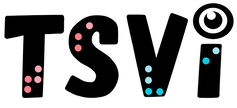- Home
-
Learn
- History of VI >
- Legislation & Laws >
- Vision Professionals >
-
VI Program Resources
>
- Program Printables
- Itinerant Teaching Tips
- Year at a Glance
- VI Program Handbook
- Caseload Analysis
- Organization & Time Management
- Professional Development
- Teacher Standards
- Professional Ethics
- Awards & Recognition
- APH Scholar Program
- Professional Organizations
- Certification Organizations
- Dealing with Challenges
- Professional Publications >
- Relatable Books for All Ages >
- Family Resources >
- Plan
- Basics
-
Teach
- Teaching Strategies >
-
Compensatory Skills Instruction
>
-
Social Skills
>
-
Self Determination
>
- Body Image & Acceptance
- Making Personal Goals
- My Vision Presentation
- My Self-Description
- Create a Personal Data Sheet
- Disclosure Decision
- Disability Statement
- Requesting Help
- Fighting Fears
- My Circle of Support
- Personal Responsibility
- Advocate for Safe Enviroments
- Having Picture Taken
- Coping with Change
- Aging Eyes
- Physical Characteristics
- Political Activism
- Laws Regarding Persons with Disabilities
-
Sensory Efficiency
>
-
Independent Living
>
- Orientation & Mobility Instruction >
- Recreation & Leisure >
-
Career & Vocation
>
-
Grow
- Complete Set Bonus >
-
Recorded Presentations
>
- Webinar: Tips for Being a "Physically Fit" TVI
- Webinar: The Art of Teaching the ECC
- Webinar: Virtual & F2F Strategies
- Webinar: Foundations of Teaching the ECC in the Age of Virtual Instruction
- Webinar: Itinerant Teaching Strategies
- Webinar: Using Themes to Teach the ECC
- Webinar: Conducting a FVLMA
- Webinar: Selecting the Right AT
- Webinar: Developing SMARTER Goals
- Webinar: Determining Service Intensity Using the VISSIT
- Webinar: Activities to Teach the ECC
- Webinar: Accessible Content for BLVI
- Webinar: Accommodations for VI
- Webinar: MIMO Strategies & Activities
- Webinar: SIDPID Strategies & Activities
- Webinar: Standard Course of Study Strategies & Activities
- Webinar: Job Tasks for Job, Career & Life
- Shop
- Jobs
General VI Resource BooksThe following are resource books and online resources specific to working with students who are blind or visually impaired. If there are additional resource books or websites you feel should be listed here, please let me know and I will add them.
Affiliate Link DisclaimerTeaching Students with Visual Impairments is a participant in the Amazon Services LLC Associates Program, an affiliate advertising program designed to provide a means for sites to earn advertising fees by advertising and linking to amazon. As an affiliate, I earn from qualifying purchases. While I appreciate your support, please compare prices from other retailers that sell these products. Thank you in advance for your support! 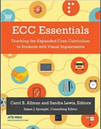
Allman and Lewis. ECC Essentials: Teaching the Expanded Core Curriculum to Students with Visual Impairments. American Foundation for the Blind, 2014. ECC Essentials: Teaching the Expanded Core Curriculum to Students with Visual Impairments is the first comprehensive book for teachers of students with visual impairments to focus on the nine areas of the ECC that encompass the unique skills children and adolescents with visual impairments need to learn in order to access the core educational curriculum and become independent individuals, by providing the rationale, suggestions, and strategies necessary to implement instruction.
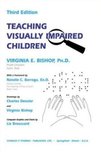
Bishop, Virginia. Teaching Visually Impaired Children, 3rd Edition. Charles C Thomas Pub Ltd, 1996. The skills emphasized in Bishop's book encourage interdependence as well as independence, and the teacher who follows its guidelines can build a learning environment that allows the student choices and opportunities for the best education.

Cassin, Barbara M. Dictionary of Eye Terminology. Triad, 2006. This dictionary is a must for Teachers of Students with Visual Impairments. It makes ophthalmic terminology accessible and understandable to all. It is a handy and easy-to-use guide for looking up unfamiliar terms and finding definitions. It also includes a list of abbreviations and acronyms.
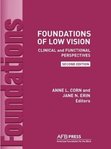
Corn and Erin. Foundations of Low Vision: Clinical and Functional Perspectives, 2nd Edition. American Foundation for the Blind, 2010. This text highlights the importance of the functional reality of low vision. It presents how to assess and support both children and adults with low vision and plan programs and services focused on optimizing people's functional vision and ability to lead productive lives.
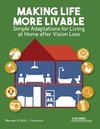
Duffy, Maureen. Making Life More Livable: Simple Adaptations for Living at Home After Vision Loss. American Foundation for the Blind, 2015. Making Life More Livable is an important resource for older adults who are losing their vision and the family members who support them. This large-print book provides practical tips and easy modifications that improve the safety and security of the home and give older adults with vision loss solutions to continue living independent and productive lives.
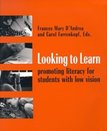
D'Andrea, Frances Mary. Looking to Learn: Promoting Literacy for Students With Low Vision. American Foundation for the Blind, 2000. This book provides teachers with practical tips and advice on improving literacy skills for students with low vision. It discusses interpreting eye reports, performing functional vision assessments, working with low vision service providers and more. All these resources assist the teacher in helping the student use their vision effectively.
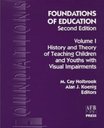
Holbrook and Koenig. Foundations of Education, Second Edition Vol I: History and Theory of Teaching Children and Youths with Visual Impairments. A comprehensive look at the history and theory of teaching children and youths with visual impairments.
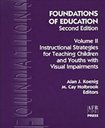
Holbrook and Koenig. Foundations of Education, Second Edition Vol II: Instructional Strategies for Teaching Children and Youths with Visual Impairments. A comprehensive compilation of best practices specific to each area of the core curriculum.
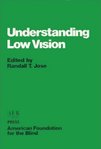
Jose, Randall T. Understanding Low Vision. American Foundation for the Blind, 1983. This text covers the fundamentals, assessment, clinical services, training, and instructional services for students with visual impairments. It discusses the impact of low vision on functioning, learning, and psychosocial status.
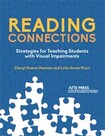
Kameie-Hannan and Ricci. Reading Connections: Strategies for Teaching Students with Visual Impairments. American Foundation for the Blind, 2015. This is a hands-on guide for teachers and professionals working to improve the reading skills of their students through the development of the essential components of reading – phonemic awareness, phonics, reading fluency, vocabulary, and reading comprehension. It addresses the needs of students who read print, braille, or both and is consistent with methods for teaching reading to students who have or are at risk for, developing reading disabilities.
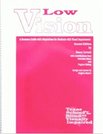
Levack, Stone, and Bishop. Low Vision: A Resource Guide with Adaptations for Students with Visual Impairments. Texas School for the Blind and Visually Impaired (TSBVI), 1994. This text discusses the challenges of programming for students who are visually impaired, the role of the instructor, the range of programming needs including those who are at their developmental level, significantly delayed and those with Cortical Visual Impairments.
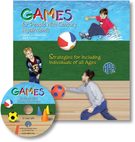
Lieberman, Lauren J. GAMES for People with Sensory Impairments Strategies for Including Individuals of All Ages. AFB Press, 2011. This resource book provides information on what to do, how to do it and why. It helps teachers locate games and activities that are appropriate for students with visual impairments. The Game Finder Key identifies each game by name, category, sport skill,physical and motor fitness, and fundamental motor patterns and skills.
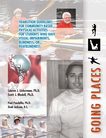
Lieberman, Lauren J. Going Places, Resource Guide. American Printing House for the Blind, 2006. This book provides transition guidelines for students with visual impairments. It is a resource guide for teens and young adults that promotes independent physical activity. It outlines a step-by-step process for choosing and participating in sports and other physical activities outside of the school arena.
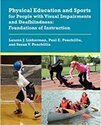
Lieberman, Lauren J. Physical Education and Sports for People with Visual Impairments and Deafblindness: Foundations of Instruction. AFB Press, 2012. This resource book provides suggestions on teaching the skills that will enable both children and adults with visual impairments and deafblindness to participate in physical education, recreation, sports, and lifelong health and fitness activities.
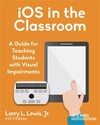
Lewis, Larry S. iOS in the Classroom: A Guide for Teaching Students with Visual Impairments. American Foundation for the Blind, 2016. iOS in the Classroom is a fully illustrated step-by-step guide to teaching the use of the iPad running iOS 9 to students with visual impairments. The book explores accessibility options available, where to find them, and how to configure them. Also included is information on finding and managing content, using the iPad for a range of online activities, and utilizing specific apps, all geared to enabling students with visual impairments to use the iPad for the same classroom tasks as their peers and ensuring their success in the classroom.
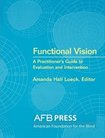
Lueck, Amanda Hall. Functional Vision: A Practitioner's Guide to Evaluation and Intervention. American Foundation for the Blind, 2004. This text presents a systematic, comprehensive, integrated approach to assessing functional vision and delivering appropriate services determined by evaluation results and link intervention to assessment findings.
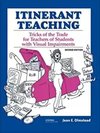
Olmstead, Jean E. Itinerant Teaching: Tricks of the Trade for Teachers of Students with Visual Impairments, 2nd ed. American Foundation for the Blind, 2005. This book is designed to help the itinerant teacher of the visually impaired manage the school year, organize materials and times, schedule and program events and activities, work in teams, travel, negotiate varying school environments, and deal with diverse caseloads.
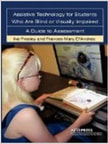
Presley and D'Andrea. Assistive Technology for Students Who are Blind or Visually Impaired: A Guide to Assessment. AFB, 2009. This resource book provides clear information on how to access information, select appropriate tools and strategies and assess a student's skills.
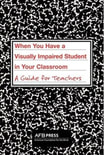
Spunqin, Susan. When You Have a Visually Impaired Student in Your Classroom: A Guide for Teachers. American Foundation for the Blind, 2002. This guidebook is written for teachers and addresses how to effectively work with a student with visual impairments and introduces special devices that may be used by the student.

Swallow, Rose-Marie. How to Thrive Not Just Survive: A guide to independent skills for blind and visually impaired children and youth. American Foundation for the Blind, 1987. This book is a practical, hands-on guide for parents, teachers, and everyone involved in helping children develop the skills necessary for socialization, orientation and mobility, and leisure and recreational activities.
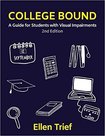
Trief, Ellen. College Bound: A Guide for Students with Visual Impairments. American Foundation for the Blind, 2016. The transition from high school to college is a significant turning point in life, but it can come with unique challenges if you are a student who is blind or visually impaired. This resource helps students prepare for their new life in college, develop useful skills, and negotiate for and coordinate appropriate services.
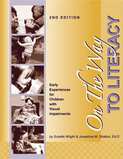
Wright and Stratton. On the Way to Literacy Handbook, 2nd edition. American Printing House for the Blind. 2007. This revised version, available from APH with quota funds, includes comprehensive information about emergent literacy. It brings together material from a variety of sources to give teachers and parents information about how literacy develops for a young child with a visual impairment, from birth until the child begins to read and write. It discusses areas of development that form a foundation for literacy and everyday activities that support a child’s learning in these areas.
Braille Resource Books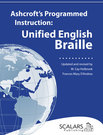
Ashcroft's Programmed Instruction in Braille, Fourth Edition (APIB), formerly titled, New Programmed Instruction in Braille Instruction. Although I used an older edition before the introduction of the UEB braille code, this is the program I used when learning braille. It is programmed with current English Braille American Edition rules integrated, cross-referenced and summarized throughout. Fourth Edition revisions include the latest BANA rule changes. The Fourth Edition continues the use of ink-printed braille for easier reading. Chapters and exercises are meaningful, human-interest material along with answer keys for immediate feedback and self-correction. Newly validated tests and answer keys facilitate learning independently or with a class and instructor.
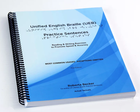
Becker, Roberta. Unified English Braille Practice Sentences. This book of practice sentences, available from ActualTactuals, was created by the co-author of Literary Braille Practice Sentences (with Phil Mangold). It is available in both print and braille and includes all UEB contractions. Sentences progress from simple to complex, making it easy to select appropriate exercises for individual students. The print book includes simulated braille on facing pages. The contractions are introduced one at a time where possible with sufficient repetition for mastery. The book progresses through all of the various types of braille contractions.
Cleveland, Jeri. Braille FUNdamentals. Texas School for the Blind and Visually Impaired (TSBVI). This resource book is a program for teaching the braille code. The program can be used with beginning braille readers as well as those who need additional practice in reading and writing. Activity suggestions are designed for a variety of age levels. This book includes a pre-braille assessment, braille checklists, and ideas for games.
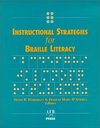
D'Andrea, Frances Mary. Instructional Strategies for Braille Literacy. American Foundation for the Blind (AFB), 1997. It provides specific strategies and methodologies for teaching braille. It provides strategies for working with students with additional disabilities as well. It also contains information on assessment and technology and includes assessment forms.
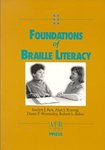
Koenig, Wormsley, Baker, Rex. Foundations of Braille Literacy. American Foundation for the Blind (AFB), 1994. This resource book addresses the teaching of braille reading and writing in the context of literacy in general, the whole language approach, and how print reading and writing are taught. A combination of theory and practice. Areas covered include perspectives on literacy; history of literacy for people who are blind; learning process of people who are blind; changing views on teaching reading and writing; braille reading literacy; and braille writing literacy. The book also covers assessment of braille literacy skills.
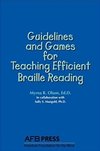
Olson, Myrna R. Guidelines and Games for Teaching Efficient Braille Reading. American Foundation for the Blind (AFB), 1981. This resource book provides unique guidelines and games that can be used in adapting a general reading program to the needs of braille readers and enriching early instruction in braille.
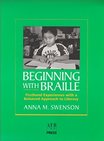
Swenson, Anna M. Beginning with Braille: A Balanced Approach to Literacy American Foundation for the Blind (AFB), 1999. This resource book provides activities and creative and practical strategies for promoting literacy at the early stages of braille instruction. It also includes tips on designing worksheets, introducing braille contractions, teaching the use of the braillewriter, and facilitating the writing process in braille. The book also addresses guidelines for designing individualized instruction, the literacy of students with additional disabilities, and assessment of student progress in developing braille literacy skills.
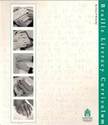
Wormsley, Diane P. Braille Literacy Curriculum. Towers Pr Overbrook School for the Blind, 2000. Presents strategies for incorporating braille into the total curriculum.This book includes ideas and practical tips and techniques for teaching braille. Suggestions included are appropriate for those with and without additional physical or cognitive disabilities. Areas covered include creating braille-rich environments, selecting and teaching key words, teaching tactile perception skills, encouraging writing skills, creating stories, and keeping records.
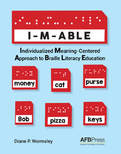
Wormsley, Diane. I-M-Able: Individualized Meaning Centered Approach to Braille Literacy Education. American Foundation for the Blind, 2016. I-M-ABLE, or the Individualized Meaning-Centered Approach to Braille Literacy Education, is an innovative, individualized, student-centered method for teaching braille and making it exciting for children who have difficulties learning braille. In this teaching approach, instruction is centered on continuously analyzing the strengths and needs of students, placing particular emphasis on engaging them using key vocabulary words and phrases based on their experiences and interests.
The Instruction Manual for Braille Transcribing - Fifth Edition, 2009 is designed for use by students in the correspondence course in English braille transcribing conducted by the Library of Congress, National Library Service for the Blind and Physically Handicapped (NLS), and for use by instructors of braille classes. The course is intended to familiarize the student with the braille system, with braille contractions and their usage, and with the rules of braille transcribing. Rules are set forth by the Braille Authority of North America (BANA) and published in English Braille American Edition (EBAE).
O&M Resource Books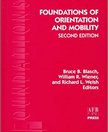
Blasch, Bruce B. Foundations of Orientation and Mobility. American Foundation for the Blind, 3rd edition 2010. Includes current research from a variety of disciplines, an international perspective and expanded contents on low vision, aging, multiple disabilities, accessibility, program design, and adaptive technology. Explores all aspects of O&M learning and instruction.
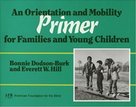
Dobson-Burk, Bonnie. Orientation and Mobility Primer for Families and Young Children. American Foundation for the Blind, 1989. This book describes the skills children with visual impairments need to move safely and efficiently. Includes sensory training, concept development, motor development, and orientation skills. It also includes suggestions for encouraging a child to move, to identify the sources of sounds, to keep track of objects, and to play successfully with others.
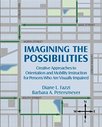
Fazzi, Diane L. Imagining the Possibilities: Creative Approaches to Orientation and Mobility and Mobility Instruction for Persons Who Are Visually Impaired. American Foundation for the Blind, 2001. This book explores methods of teaching O&M to persons who are blind or visually impaired including those with multiple disabilities. Includes materials, samples, and creative teaching strategies.
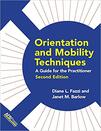
Hill, Everette W. Orientation and Mobility Techniques: A Guide for the Practitioner. American Foundation for the Blind, 1976. This manual covers the definitions, techniques, and devices. It is designed for all professionals concerned with the mobility training process.

Knott, Natalie Isaak. Teaching Orientation and Mobility in the Schools: An Instructor's Companion. American Foundation for the Blind, 2002. This manual is designed to help O&Ms discover the best methods of teaching O&M in schools. Includes useful forms, checklists, and tips on planning schedules, organizing equipment and work routines, working with school personnel and educational team members and effectively provide instruction to children with diverse needs.
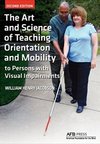
Jacobson, William H. Art and Science of Teaching Orientation and Mobility to Persons with Visual Impairments. American Foundation for the Blind, 2nd edition 2012. This book provides a comprehensive description of the techniques of teaching orientation and mobility. Considerations and strategies for meeting individual needs, environmental features, and ethical issues.

LaPrelle, Lorie Lynn. Standing On My Own Two Feet. Blind Children's Center, 2002. This booklet provides a step-by-step guide to designing and constructing simple, individually tailored adaptive mobility devices made from low-cost PVC materials. These devices are intended to enable preschool age children who are blind to begin to master independent travel.
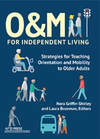
Page, et. al. O&M for Independent Living: Strategies for Teaching Orientation & Mobility to Older Adults. American Foundation for the Blind, 2016. This book is a guide for orientation and mobility instructions, rehabilitation specialists, occupational therapists, and other professionals who work with adults who may be new to vision loss. It provides insights essential for helping these individuals remain independent and self-reliant. In addition to information on the effects of aging and considerations for assessment and instruction, chapters include strategies on adapting O&M skills for older adults, environmental modifications and appropriate equipment, exercise and its relationship to mobility, daily living skills, and effective collaboration among the professionals who serve this population.
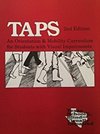
Pogrund, Rona, et al. An Orientation & Mobility Curriculum for Students with Visual Impairments, 3rd Edition. TSBVI, 2012. For orientation and mobility specialists who serve students ages 3 to 21 who may also have other impairments. This curriculum includes goals, objectives, and teaching strategies as well as functional mobility tasks, for the following environments home/living, campus, residential, commercial and public transportation, as well as an ambulatory devices section. The four-part set also includes extensive appendices containing a wide range of O&M related topics and a supplement that details street crossing strategies.
Early Intervention & Early Childhood Resource Books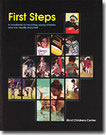
Anthony, Chen, Fazzi, et al. First Steps. The Blind Children's Center, 1993). This handbook for teaching young children who are visually impaired provides a foundation and an overview of issues and concerns to families. Topics include early childhood development, professionals, the eye, the family, behavior management, speech/language, sensorimotor development, O&M skills, self-help skills, IEPs and materials and devices for children with visual impairments.
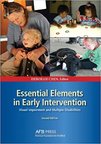
Chen, Deborah. Essential Elements in Early Intervention: Visual Impairment and Multiple Disabilities. American Foundation for the Blind (AFB), 1998. Contains explanations of both functional and clinical vision assessments, descriptions of evaluative and educational techniques, as well as suggestions on working with families and within professional teams.
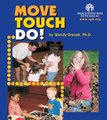
Derezek, Wendy. Move, Touch, Do. American Printing House for the Blind. From APH: This curriculum provides children opportunities to develop the awareness and skills to prepare them to enter formal education. Primarily for professionals. Materials provide an outline of daily activities, a structure of materials and skills for the school year, instructions for craft projects and sample communication boards.

Holbrook, M. Cay. Children with Visual Impairments: A Parents' Guide (Special Needs Collection). Woodbine House, 1995. Topics include: diagnosis and treatment; family life and adjustment; your child's development; Early Intervention and Special Education; literacy; Orientation & Mobility; multiple and visual disabilities; legal issues and planning for the future.

Pogrund, Rona L & Fazzi, Diane L. Early Focus: Working With Young Children Who Are Blind or Visually Impaired and Their Families. American Foundation for the Blind (AFB), 2002. Provides descriptions of early intervention techniques with children that are blind and visually impaired. Practical applications and strategies relating to cognitive and language development, orientation and mobility, social skills, early intervention, and program development.
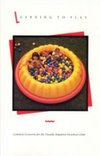
Recchia, Susan L. Learning to Play. Blind Children's Center, 1987. This booklet focuses on the importance and necessity of play in children's development. Students who are blind or visually impaired can have difficulty in exploring toys and materials, making transitions from one activity to another and playing with other children. This booklet provides suggestions for parents and professionals for helping students in these areas.

Schwarts and Miller. The New Language of Toys: Teaching Communication Skills to Children with special Needs: A Guide for Parents and Teachers. Woodbine House, 1996. A guide about using everyday toys to develop communication skills in children with disabilities and making playtime a fun, exciting and educational experience.
Social Skills Resources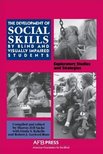
Gaylord-Ross, Robert J. Development of Social Skills by Blind and Visually Impaired Students: Exploratory Studies and Strategies. American Foundation for the Blind, 1992. This text examines the social interactions of children with visual impairments. Theory and research are combined with practical strategies to explore how children can be helped to succeed socially.
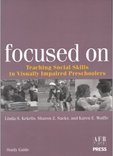
Kekelis, Sacks, Wolffe. Focused On: Teaching Social Skills to Visually Impaired Preschoolers Study Guides. American Foundation for the Blind, 2000. This module provides information on ways to support the social development of young children with visual impairments.
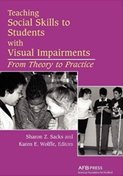
Sacks, Sharon. Teaching Social Skills to Students with Visual Impairments: From Theory to Practice. AFB, 2006. This resource book explores what theory can tell us about how children who are visually impaired become socially skilled individuals. It then provides techniques and strategies for helping students develop and refine social skills.
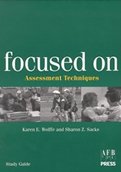
Sacks and Woffe. Focused On: Assessment Techniques Study Guides. American Foundation for the Blind, 2000. This module focuses on assessment techniques for evaluating the social skills of students who are blind or visually impaired.
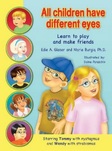
Glaser, Edie. All Children Have Different Eyes: Learn to Play and Make Friends...Starring Tommy and Nystagmus (wobbly eyes) and Wendy with Strabismus (crossed eyes). This interactive workbook models for children with visual impairments how to confidently and competently play and make friends while facing difficult social challenges, such as how to answer questions about their condition, enter play groups, and handle their limitations responsibly.
|
History of Visual Impairments
Professional Practice
Vision Professionals
Professionalism
Teacher Resources
Professional Publications
VI Book Resources
|
|
Teaching Students with Visual Impairments LLC
All Rights Reserved |
- Home
-
Learn
- History of VI >
- Legislation & Laws >
- Vision Professionals >
-
VI Program Resources
>
- Program Printables
- Itinerant Teaching Tips
- Year at a Glance
- VI Program Handbook
- Caseload Analysis
- Organization & Time Management
- Professional Development
- Teacher Standards
- Professional Ethics
- Awards & Recognition
- APH Scholar Program
- Professional Organizations
- Certification Organizations
- Dealing with Challenges
- Professional Publications >
- Relatable Books for All Ages >
- Family Resources >
- Plan
- Basics
-
Teach
- Teaching Strategies >
-
Compensatory Skills Instruction
>
-
Social Skills
>
-
Self Determination
>
- Body Image & Acceptance
- Making Personal Goals
- My Vision Presentation
- My Self-Description
- Create a Personal Data Sheet
- Disclosure Decision
- Disability Statement
- Requesting Help
- Fighting Fears
- My Circle of Support
- Personal Responsibility
- Advocate for Safe Enviroments
- Having Picture Taken
- Coping with Change
- Aging Eyes
- Physical Characteristics
- Political Activism
- Laws Regarding Persons with Disabilities
-
Sensory Efficiency
>
-
Independent Living
>
- Orientation & Mobility Instruction >
- Recreation & Leisure >
-
Career & Vocation
>
-
Grow
- Complete Set Bonus >
-
Recorded Presentations
>
- Webinar: Tips for Being a "Physically Fit" TVI
- Webinar: The Art of Teaching the ECC
- Webinar: Virtual & F2F Strategies
- Webinar: Foundations of Teaching the ECC in the Age of Virtual Instruction
- Webinar: Itinerant Teaching Strategies
- Webinar: Using Themes to Teach the ECC
- Webinar: Conducting a FVLMA
- Webinar: Selecting the Right AT
- Webinar: Developing SMARTER Goals
- Webinar: Determining Service Intensity Using the VISSIT
- Webinar: Activities to Teach the ECC
- Webinar: Accessible Content for BLVI
- Webinar: Accommodations for VI
- Webinar: MIMO Strategies & Activities
- Webinar: SIDPID Strategies & Activities
- Webinar: Standard Course of Study Strategies & Activities
- Webinar: Job Tasks for Job, Career & Life
- Shop
- Jobs
